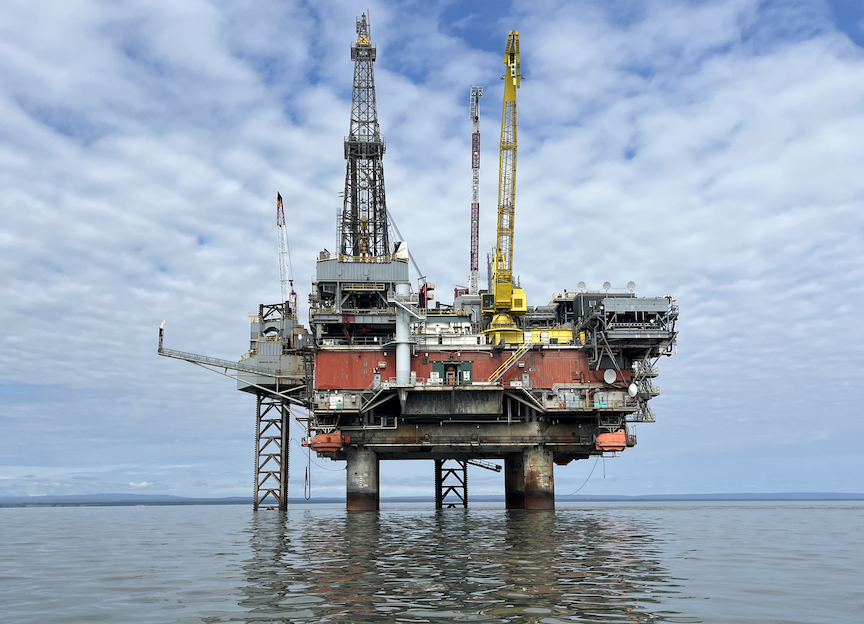Hilcorp’s Tyonek natural gas platform in Cook Inlet in 2023. A jackup drilling rig is attached to the platform and stands behind it on the latticed legs. (Photo by Nathaniel Herz/Northern Journal)
When Anchorage’s big electric utility asked regulators’ permission last year to raise its rates by 5.5%, renewable energy advocates responded with a counterproposal.
Could heavy residential users of power be charged even higher prices for each kilowatt of electricity, as a way to encourage conservation of Alaska’s dwindling supply of natural gas?
The Regulatory Commission of Alaska last week ruled on the broader rate increase requested by Chugach Electric Association.
The utility says it’s still studying the intricate, 89-page order to understand its effects.
But to the advocates who proposed the natural gas conservation scheme, there was one clear takeaway: The order made just one passing reference to their proposal, and, they say, it ignored a state law that requires the commission, when setting electricity rates, to “promote the conservation of resources” used to generate power.
“We don’t see any findings about how that was considered. And we’re in a natural gas crisis,” said Chris Rose, executive director of Renewable Energy Alaska Project, or REAP, which drafted the conservation proposal. He added: “We’re still digesting the order. But our initial impression is that they haven’t addressed an essential issue.”
REAP participated in the commission proceedings, known as a rate case, with free legal help from the environmental law firm Earthjustice. Rose and his attorneys were set to meet this week to discuss their options, which include asking the commission to reconsider its order or appealing the decision to the courts.
The commission, through spokesman Steven Jones, declined to comment, citing the potential for an appeal.
Chugach is analyzing the commission’s order “and will communicate with our members when we are clear on what it means for them,” said Julie Hasquet, a spokeswoman for the utility.
While neither Chugach nor the commission have specified how the details of the order could raise or lower the proposed 5.5% rate increase, the document does contain some clear conclusions.
The commission rejected a proposal by Chugach to raise its allowed profit margin, calculated using a financial benchmark called “times interest earned ratio,” or TIER. The utility wanted to raise its TIER — a ratio expressing how much the utility’s yearly earnings exceed its required debt payments — to 1.75 from 1.55, which, the commission said, would have raised rates by a total of $7.7 million.
In turning down that request, the commission said the existing TIER of 1.55 allows Chugach to “maintain its financial integrity” and lets the utility borrow money at “reasonable costs.”
The commission also rejected a request by Chugach to charge other utilities money to ship power across transmission lines it acquired when it bought Anchorage’s city-owned utility in 2020.
The city-owned utility did not charge those other utility customers for transmission. And the commission, in its order last week, said there was no evidence that Chugach bought the city assets for the benefit of those other utilities — concluding that they shouldn’t be charged under commission rate-setting guidelines that say costs should be paid by those who cause them.
These transmission lines connect Chugach’s aging Beluga power plant with the rest of urban Alaska’s electrical grid. (Photo by Nathaniel Herz/Northern Journal)

